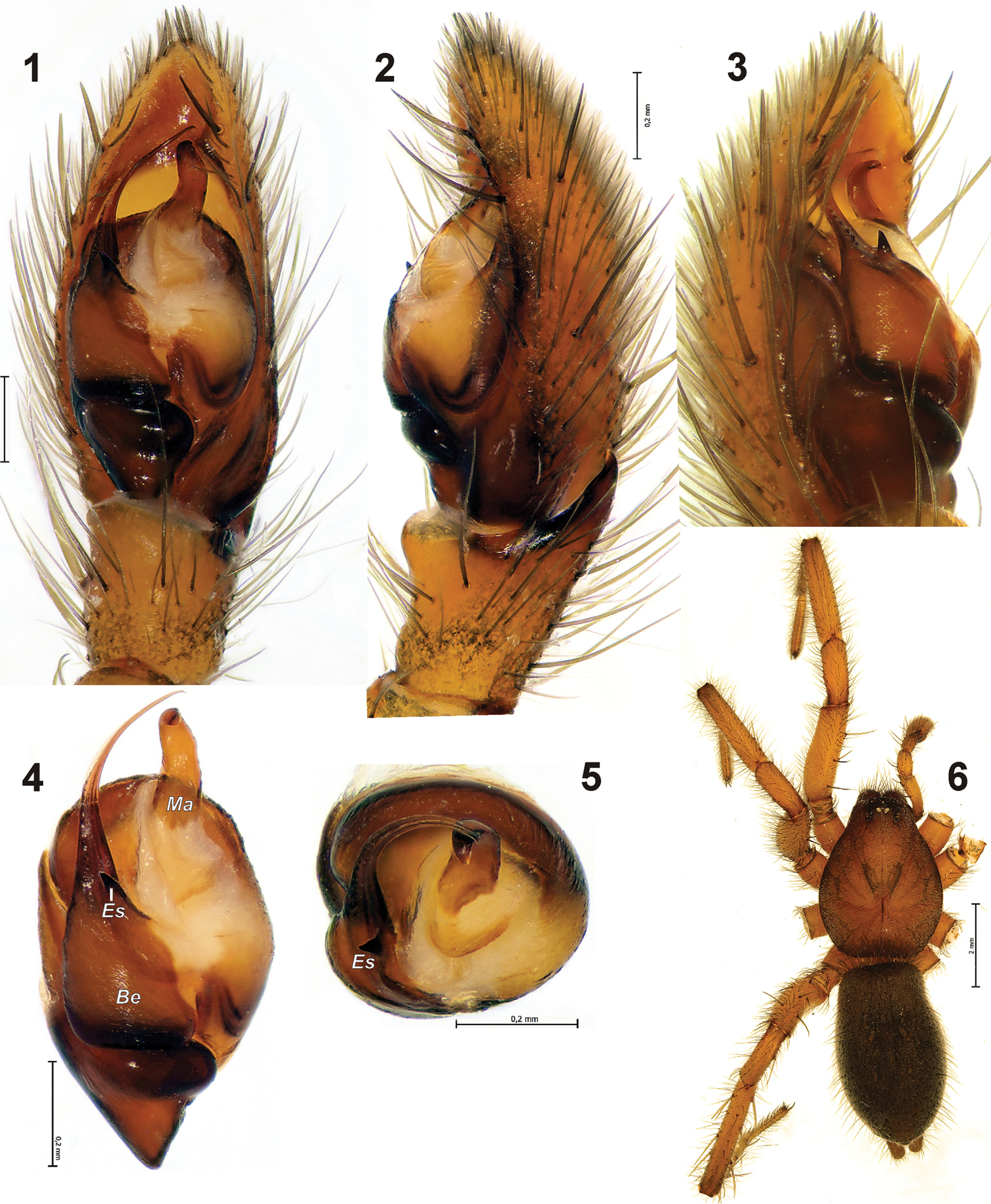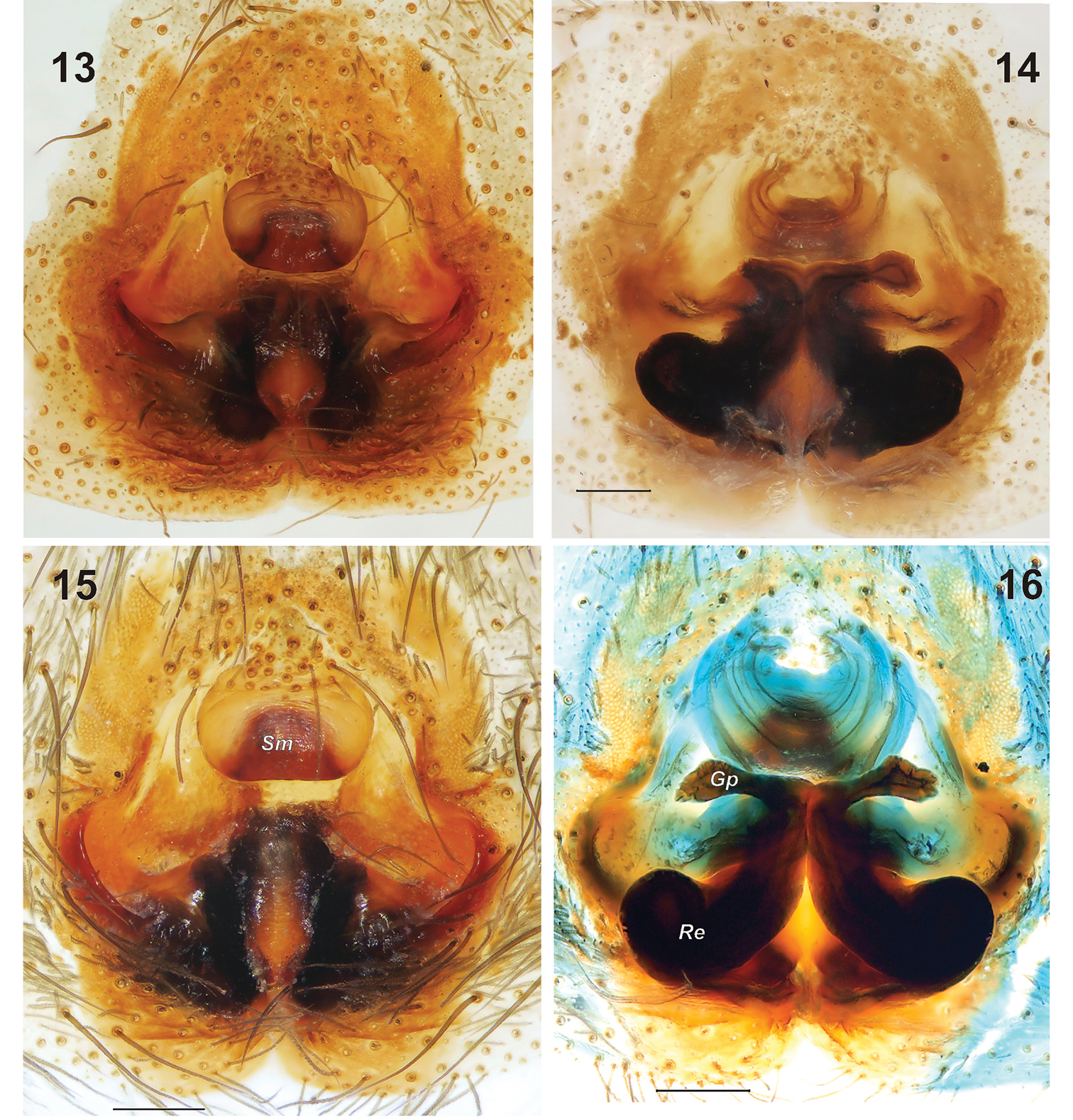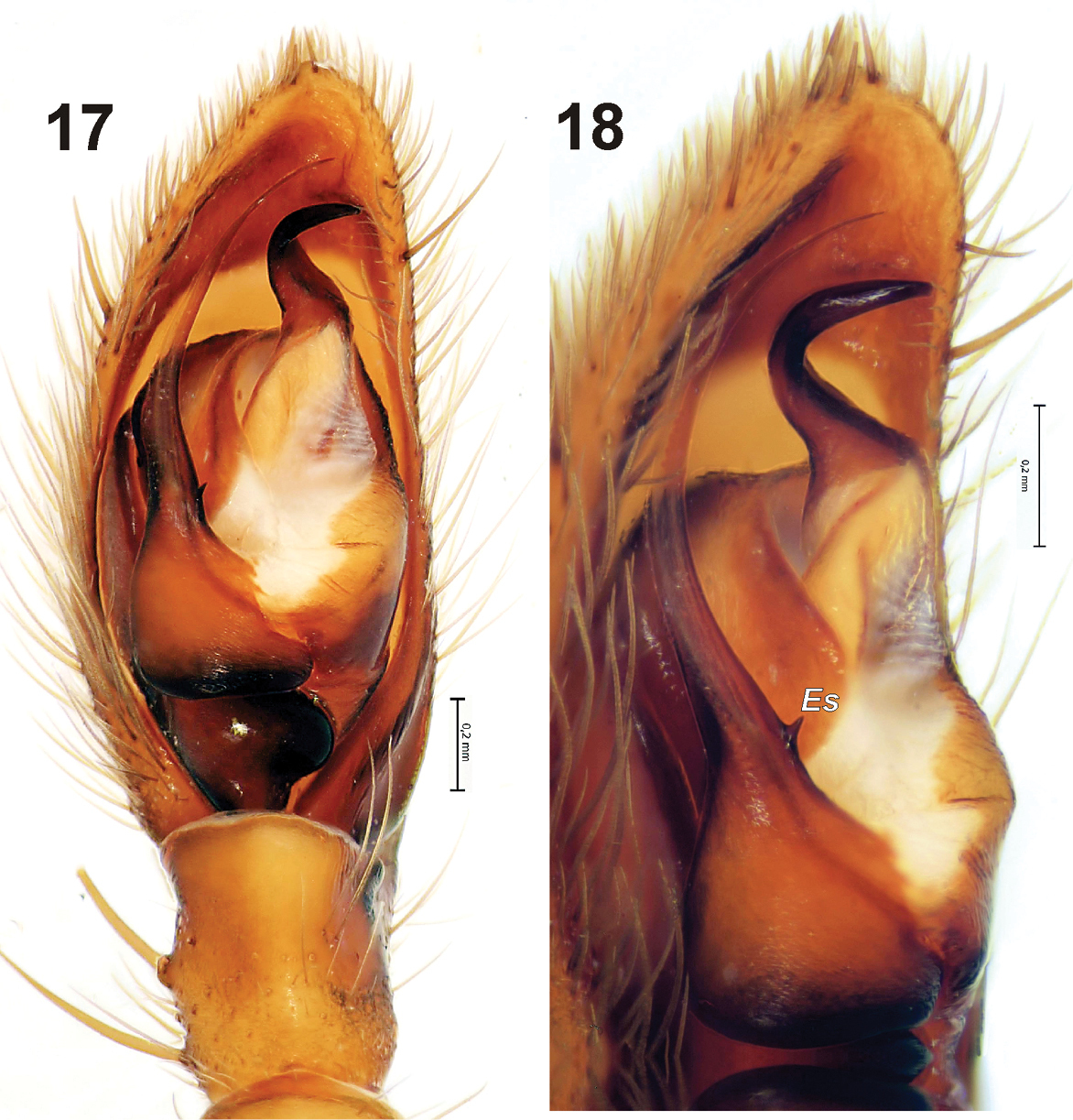






Citation: Marusik YM, Fomichev AA, Omelko MM (2014) A survey of East Palaearctic Gnaphosidae (Araneae). 2. Two new Gnaphosa Latreille, 1804 species from Western Mongolia. ZooKeys 426: 1–9. doi: 10.3897/zookeys.426.7898
Two new species: Gnaphosa khovdensis sp. n. (♂) and G. esyunini sp. n. (♂♀) are described from Khovd Aimag of Mongolia. Descriptions, figures, diagnosis and map of the records are provided. The new species are assigned to a monophyletic group together with the recently described G. ustyuzhanini Fomichev et al., 2013.
Spiders, Gnaphosinae, Mongolia, new species, taxonomy
Gnaphosa Latreille, 1804 is the third largest genus of ground spiders with 141 species (
While studying material collected in Western Mongolia and particularly in Khovd Aimag we recognized two unknown species related to each other and to the recently described Gnaphosa ustyuzhanini Fomichev et al., 2013. Goals of this paper are to provide detailed descriptions of the new species and to discuss their relationships.
Photographs were taken in dishes of different sizes with paraffin at the bottom. Specimens were photographed using an Olympus Camedia E-520 camera attached to an Olympus SZX16 stereomicroscope and the SEM JEOL JSM-5200 scanning microscope at the Zoological Museum, University of Turku. Digital images were prepared using “CombineZP” image stacking software. Illustrations of epigynes were made after maceration in 20% potassium hydroxide aqueous solution and exposition for a few minutes in an alcohol/water solution of Chlorazol Black. Lengths of leg segments were measured on the dorsal side. While describing spination of legs we use the following abbreviations: Fe – femur, Pt – patella, Ti – tibia, Mt – metatarsus. All measurements are given in mm. Material will be deposited in the Institute for Systematic and Ecology of Animals, Novosibirsk (ISEA), Institute of Zoology, Chinese Academy of Sciences, Beijing (IZCAS) and in the Museum of Natural History, Budapest (MNHB).
MONGOLIA, Khovd Aimag: holotype ♂ (ISEA), Arshantyn-Nuruu Mountain Range, 46°16'46"N, 91°16'53"E, 1560 m, mountain stony steppe, under stone, 14.05.2012 (A.A. Fomichev).
The specific name derived from Khovd Aimag, adjective.
The new species is related to Gnaphosa esyunini sp. n., Gnaphosa jucunda Thorell, 1875 and Gnaphosa ustyuzhanini by having a strong spine in the embolic base and a filamentous embolus with a serrated prolateral edge. From Gnaphosa ustyuzhanini (Figs 17–18) and Gnaphosa jucunda it can be distinguished by the prolaterally directed strong embolic spine. In addition Gnaphosa jucunda has a thick, not filamentous embolus (cf.
Male. Total length 8.5. Carapace: 4.05 long, 3.05 wide. Coloration: carapace and legs brown. Chelicerae dark brown. Sternum, labium and maxillae brown. Abdomen grayish-brown. Spinnerets light brown. Spination: I: Fe d1-1-0, p0-1-1; Ti v0-1-1; Mt v2-1-0. II: Fe d1-1-0, p0-1-1; Ti p1-0-0, v1-1-2; Mt v2-1-0. III: Fe d1-1-0, p0-1-1, r0-1-1; Pt p1, r1; Ti d1-0-0, p2-2-0, r2-1-1, v2-2-2; Mt d0-2-0, p1-1-0, r1-1-0, v2-2-0. IV: Fe d1-1-0, p0-1-1, r0-1-1; Pt r1; Ti p2-2-0, r2-1-1, v2-2-2; Mt d0-2-0, p1-1-0, r1-1-0, v2-2-0. Leg article length. I: 3.15+1.7+2.65+2.3+1.65. II: 3.0+1.6+2.4+2.3+1.65. III: 2.7+1.35+2.0+2.6+1.65. IV: 3.55+1.7+2.9+3.9+2.0.
Palp as in Figs 1–5, tibial apophysis relatively short (shorter than tibia) with sharply pointed tip bent downward; median apophysis relatively small, as long as tibia; embolus unmodified, whip like, base of embolus located on posterior 1/3 of bulbus; upper part of embolic base with beak-shaped spine; prolateral edge of embolus serrated.
Holotype of Gnaphosa khovdensis sp. n. 1–3 male palp, ventral, retro and prolateral 4–5 bulbus, ventral and from above 6 habitus. Scale = 0.2 mm if not otherwise indicated. Be – base of embolus; Es – embolic spine; Ma – median apophysis.
Female unknown.
Known from the type locality only (Fig. 19).
MONGOLIA, Khovd Aimag: Holotype ♂ (NHMB) and paratypes 2♀ (NHMB) with label “Nr. 666. Chovd aimak: Chovd (Kobdo), ca 5 km SW von der Stadt, 1500 m, 10.VII.1966. – Von kahlen, felsigen Bergen umgegebener Tal mit sandigem Schotter, geeinzelt unter Steinen, vom Boden und zwischen den Pflansenwurzeln, sowie von den Pflanzen”; 1 ♀ (IZCAS), collecting number: mk408, 18.5 km of Monhhairhan Town, Monhhairhan Sum, Khovd Aimag, Mongolia, 47.22783°N, 91.89552°E, 1945 m, 22.07.2011 (Meng Kaibayier).
Different maps provide different spelling of Monhhairhan, one alternative spelling is Monkh Khayrkhan.
The species is named after our colleague Sergei L. Esyunin from Perm University (Russia), noun.
Males of the new species differ from all congeners by the large embolic spine directed prolaterally. Females of Gnaphosa esyunini sp. n. substantially differ from other species by the very wide fovea and the shape and angle of the lateral pockets.
Male. Total length 14.4. Carapace: 7.3 long, 5.6 wide. Coloration: carapace and legs brown. Labium, maxillae and sternum dark brown. Chelicerae dark brown, almost black. Abdomen grayish-brown. Spinnerets light brown. Spination: I: Fe d1-1-0, p0-0-1; Ti v0-1-1; Mt v0-2-0. II: Fe d1-1-0, p0-1-1; Ti v0-0-1; Mt v0-2-0. III: Fe d1-1-0, p0-1-1, r0-1-1; Pt p1, r1; Ti d1-0-0, p3-1-1, r2-1-1, v2-2-2; Mt d0-2-0, p2-1-0, r1-1-0, v0-3-2. IV: Fe d1-1-0, p0-1-1, r0-1-1; Pt r1; Ti p2-3-3, r3-2-3, v4-1-4; Mt d0-3-0, p3-4-1, r3-1-0, v3-3-3. Leg article length. I: 5.7+3.3+5.25+4.4+2.65. II: 5.3+3.0+4.75+4.4+2.75. III: 4.85+2.5+3.85+5.05+2.65. IV: 6.0+3.0+5.2+7.25+3.05.
Palp as in Figs 7–11; tibial apophysis with parallel margins and triangle-shaped tip; median apophysis relatively large and strong, partly turned due to inflation of distal haematodocha; base of embolus with long spine directed prolaterally and small teeth below the spine; prolateral edge of embolus distinctly serrated.
Holotype of Gnaphosa esyunini sp. n. 7–9 male palp, ventral, retro and prolateral 10–11 bulbus, ventral and from above 12 habitus. Scale = 0.2 mm if not otherwise indicated. Be – base of embolus; Es – embolic spine; Ma – median apophysis; Se – serrated edge of embolus.
Female. Total length: 15.5. Carapace: 8.3 long, 6.15 wide. Coloration as in male. Spination: I: Fe d1-1-0, p0-0-1; Ti v0-1-1; Mt v0-2-0. II: Fe d1-1-0, p0-1-1; Ti p0-0-1, v0-1-2; Mt p1-0-0, v0-2-0. III: Fe d1-1-0, p0-1-1, r0-1-1; Pt p1, r1; Ti d2-0-0, p3-1-1, r2-1-1, v2-2-2, Mt d0-2-0, p2-1-0, r2-1-0, v2-0-2. IV: Fe d1-1-0, p0-1-1, r0-1-1; Pt r1; Ti p3-1-1, r2-1-2, v2-3-2; Mt d0-2-0, p2-2-0, r2-1-1, v2-1-2. Leg length. I: 5.9+3.6+4.9+3.95+2.8. II: 5.55+3.35+4.55+4.0+2.8. III: 5.05+2.75+3.8+4.7+2.8. IV: 6.15+3.3+5.3+7.1+3.2.
Epigyne as in Figs 13–16; fovea very wide, especially in posterior half, 2.2 times wider than scape; scape oval, wider than long, with large hood; lateral pockets long, at an angle of about 45° to epigastral fold; glandular part of receptacles stretched horizontally.
Epigyne of Gnaphosa esyunini sp. n. 13, 15 ventral 14, 16 dorsal, after maceration. Scale = 0.2 mm. Gp – glandular part of receptacle; Re receptacle; Sm – scape.
Known only from two localities in Khovd Aimag (Fig. 19).
MONGOLIA: Khovd Aimag: 1♂ (NHMB) with label “Nr.649, Z.Kaszab, Chovd aimak: Mongol Altaj Gebirge, Tal des Flusses Uenč gol, cca 64 km N von Somon Uenč, 2100 m, 8.VII.1966. – Im Flusstal unter Steinen geeinzelt, resp. geschossen.”
The type series of this species was collected at the same place where the type locality of Gnaphosa khovdensis sp. n. is located. The newly examined specimen has a more prominent embolic spine than in the holotype and paratype males.
Male palp of Gnaphosa ustyuzhanini. 17 ventral 18 prolateral. Scale = 0.2 mm. Es – embolic spine.
Collecting places of Gnaphosa khovdensis sp. n. (square), Gnaphosa esyunini sp. n. (circle) and Gnaphosa ustyuzhanini (filled cross – new locality, open crosses – earlier records).
Although Gnaphosa can be considered as a well studied genus and contains almost 150 species it was never subdivided into monophyletic groups on a global scale. Asian species have been assigned into 10 informal species groups (
It seems that the three Mongolian species treated here, all from Khovd Aimag, form a monophyletic group, which shares the same characters such as the short tibial apophysis (not longer than tibia); raised base of embolus; base of embolus with spine in anterior part; filamentous and rounded embolus with serrated prolateral edge; and simple median apophysis with claw-like tip. Members of other Asian species groups may have any mentioned character but never all together. For example some species in the lugubris-group have a triangle or claw-like spine on the base of embolus, but never an anterior spine and they have a modified median apophysis with an enlarged base. Members of the muscorum-group have a filamentous curved embolus and short tibial apophysis, but with the base of the embolus low, never having a spine but rather a kind of spur or serrated keel. Species of the rufula-group have a spine or claw-like embolic tooth or nearly a spine, but have a long tibial apophysis and straight embolus, and/or modified median apophysis.
We thank R.V. Yakovlev (Barnaul, Russia), A.N. Nakonechnyi (Novosibirsk, Russia), A.I. Shmakov (Barnaul, Russia), G.G. Khabiev (Aktash, Russia), U. Beket (Bayan-Ölgii, Mongolia) for organizing and undertaking an expedition to Mongolia, in which the part of material treated in this paper was collected. Material collected by Z. Kaszab in Mongolia was kindly provided by late S. Mahunka (NHMB, Budapest). Also, we thank S. Koponen (University of Turku) and R.Yu. Dudko (ISEA) for providing museums facilities. English of the earlier draft was kindly checked by Donald Buckle (Saskatoon, Canada) and David John Court (Singapore). This work was supported in part by the Russian Foundation for Basic Research (grant 12-04-01548).




